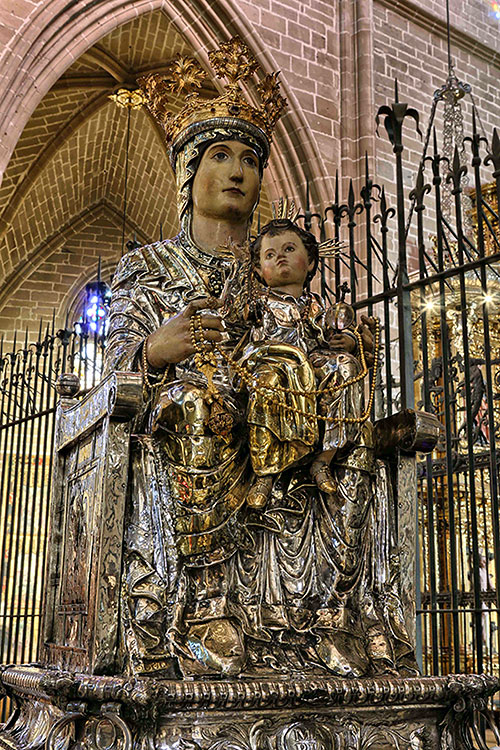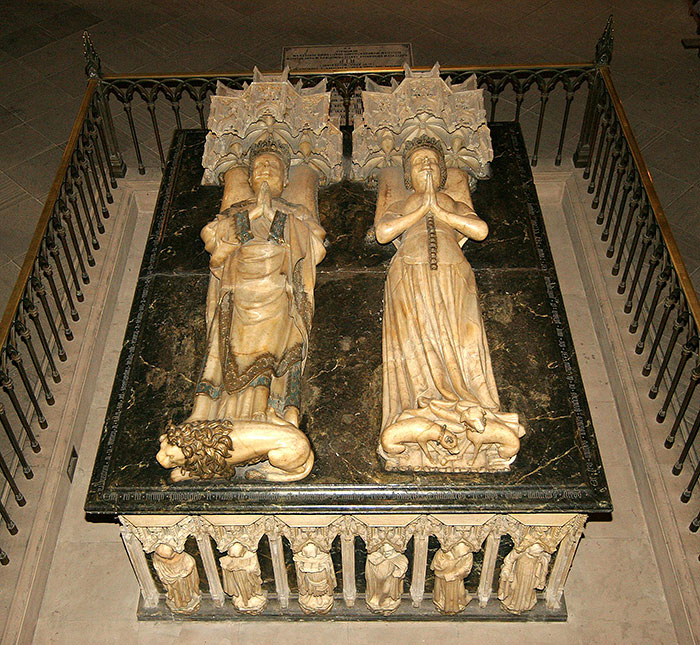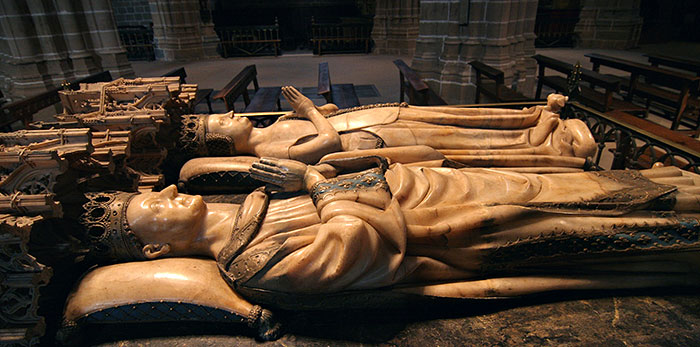June 14
Movable art in the cathedral of Pamplona: Age average
Clara Fernández-Ladreda Aguadé
Chair of Navarrese Heritage and Art
In the lecture on site, some of the most relevant medieval works housed in Pamplona's cathedral were explained: specifically the titular image, Santa María de Pamplona, and the tomb of Carlos III.
Santa María de Pamplona is a Romanesque carving, from subject Sedes Sapientiae or Throne of Wisdom, the most genuinely Romanesque typology. It presided over the Romanesque cathedral, being one of the few remains that have come down to us. It is also one of the oldest preserved Marian images of Navarre, very probably the oldest together with that of Irache.
It has experienced some losses and damages that alter its original appearance, especially the disappearance of the Child -replaced by a baroque one- and the incorporation of a neo-renaissance throne in the 19th century.

Santa María de Pamplona
Among its most outstanding features are the employment a metallic silver cover -except for the face and hands- and the complex and original Marian costume composed of tunic, surcoat, Closed mantle and headdress. The first, without being totally exceptional, is much rarer than the simple polychrome wood, since it was much more expensive and therefore only within the reach of relevant and wealthy institutions. The second is a unique case within the European and Hispanic Marian imagery, and within Navarre we only find it in images derived from those of Pamplona and Irache.
As for its functions, in addition to worship, it is an image that performed other functions: reliquary, as it houses a deposit of relics in its head, some of which are very picturesque; juradera, as the kings of Navarre swore before it on the day of their coronation; and processional, as it was taken in procession, both on fixed dates - August 15, feast of the Assumption, the dedication of the temple - and in exceptional circumstances - the War of Navarrería in 1276 -.
It bears a close resemblance to the one in the monastery of Irache, today in the parish of Dicastillo. Both served as model to a large group of carvings from the surrounding area, the so-called "subject Pamplona-Irache", among which stand out those of Berriozar, Aldaba, Echalaz, Villatuerta -whereabouts unknown- and Rocamador de Estella.
It was probably executed after the completion of the church, consecrated in 1127, in the second quarter of the 12th century, a hypothesis corroborated by its similarities with the capitals of the Romanesque cloister.
The tomb of Charles III of Navarre and his wife Leonor of Castile can be considered one of the most outstanding European and Hispanic funerary monuments of the first half of the 15th century. It is also quite well preserved and exceptionally well documented, thanks to the Comptos records of the royal accounts.
We know that it was executed between 1413 and 1419, in Olite, in two phases. The first phase lasted from October 1413 to June 1414, when the work was interrupted because the masons went to work on the palace in Olite. Given its brevity, barely eight months, little could be done, perhaps only the architectural elements and perhaps not all of them. The work was resumed in February 1416, and continued until May-June 1419, when the tomb was moved to the cathedral. This is a much longer period than the previous one, three and a half years, so it has been considered that it was at this stage when the bulk of the work was done.

Sepulchre of Charles III and his wife. Set
We also know from the comptos records the names of the artists who were involved. First of all, Johan de Lome, who was the director of the business and is the one who was paid the most, as he had a fixed monthly salary, in addition to the daily wage or the payment for finished work. He came from the southern Netherlands (now Belgium), probably from Tournai, although it has also been suggested that he came from Lomme, a town near Liège, now absorbed by this city. He must have been hired by Charles III during his last trip to France (1408-1411), since the first news we have of his presence in Navarre dates back to August 1411.
Next to them, the documentation quotation lists the names of other artists, all of them foreigners, French or from the southern Netherlands -like Lome himself-, who received a daily salary, the same in all cases. Some worked throughout the entire process, such as Hanequin de Sora and Michel de Reims. Others took part in only one of the phases: either the first, such as Johan de Lille, Johan de Burgundy and Vincent Huyard, who must have done little, or the second, such as Johan de la Garnia and Colin de Reims.
It is a sepulchre of subject sepulchral bed exempt, double, with recumbents on the lid and the funeral cortege -plorants-, deployed by the sides. The sepulchral bed is made of sandstone and was originally painted black, but in 1902-1903 this color was replaced by a green with white veins, imitating marble. The sculptures, canopies and pedestals are made of alabaster from Sástago and are enriched with touches of polychrome.
The recumbents are shown in frontal and hieratic posture, with their hands together in a praying attitude. It is interesting to note that they are conceived as standing figures and not lying down, being the most relevant elements of the set, undoubtedly their execution can be attributed to Lome.
Charles III wears a long tunic with tight sleeves. Over it he wears a slightly shorter surcoat, with wider sleeves, decorated with polychrome borders, with fleurs-de-lis in relief. The set is completed with a cloak subject socq or soccus, used by the kings in great solemnities, provided with a lateral opening and fastened by a brooch on the shoulder both on the right side, also decorated with golden relief ornaments and with semiprecious stones set -disappeared-. It has a crown, also gilded with ornaments in relief and semiprecious stones inlaid -lost-.
-missing-.
It is not a garment taken from contemporary fashion, but of ceremonial character, used by the kings of France at their coronation and that, from the House of Valois, began to be used in the recumbents of the monarchs, as we can see in that of Charles V of France. Among the reasons for his choice we can point out the family ties of Charles III with the Valois -his mother belonged to this family-, his Education and French tastes, but perhaps it also underlies the desire to remember his rights to the French Crown, tenaciously defended by his father.

Tomb of Charles III and his wife. Recumbents
Doña Leonor, for her part, wears a very long saya that drags along the floor, with a boat neckline, tight and long sleeves that cover the hand, the part corresponding to the body smooth and tight, and the wide skirt with pleats, complemented with a goldwork belt. Over it she wears a surcoat, a luxurious garment that covers the upper part of the body with large side openings that reveal the sackcloth and the belt, and decorated with a vertical strip of gold work. The hair is gathered by a hairnet on which she wears a crown, like that of her husband.
Contrary to what happens in the case of the monarch, it is a fashionable garment, used in contemporary or somewhat earlier images of queens or noble ladies, such as the recumbent of Joan of Bourbon, wife of Charles V of France - known from a drawing by Gaignières - and the statue of the same sovereign in the Louvre Museum.
As for the heads, the head of Charles III, of great quality and delicately modeled, has a realistic character, perhaps being a portrait. In contrast, that of Doña Leonor, as is typical of female sculptures of the period, is an idealized version.
They rest on cushions decorated with painted inscriptions with the emblem of Charles III Bonne Foy, currently visible only on the inside. Above them are canopies, authentic micro-architectures, very complex and executed with great virtuosity, with the epitaph engraved on the upper part and, in the case of the sovereign, continuing on the edge of the slab.
The feet of the kings are supported by typical symbolic animals. In the case of the monarch: a lion, symbol of courage and strength; in that of the queen, a pair of dogs disputing a bone, symbol of the brevity of human life gnawed by time, which we find in other tombs such as that of Joan of Evreux, wife of Charles IV of France and great-aunt of Charles III, and that of St. Elizabeth of Portugal.
For its part, the funerary cortege, composed of the typical plorantes, in issue of twenty-eight -six for the short sides and eight for the long ones-, unfolds along the sides of the box. All of them are covered with architectural canopies, related to those of the recumbents, but much simpler, and are supported on sculpted pedestals, mostly with animal themes, but also human and vegetal.
As usual, although there are exceptions, the plorants are male: part ecclesiastics and part laymen. Among the former we find cardinals, bishops, canons of the cathedral of Pamplona and members of other religious orders among which we can recognize a Dominican, a Franciscan and a Cistercian. On the other hand, the laymen wear mourning attire with variations depending on their closeness to the deceased or their category, from the great mourning -long tunic and long Closed round cloak-, to the attenuated mourning -long or semi-short tunic with open cloak-, to the attire of the great officers -long tunic without cloak-.
They could be grouped in pairs, whose components are very similar, since they not only belong to the same religious and social category, but also have very similar or complementary postures and gestures, and wear similar clothing with a similar disposition. Often they are two almost identical figures, to one of which the "mirror effect" has been applied. Among the clearest examples of pairs are the two cardinals and the two canons.
Unfortunately, the location of these plorants is not the original one, and it is not possible to reconstruct it, except for the ecclesiastical dignitaries -cardinals, bishops and canons- that we know occupied the head of the tomb. It is possible that, as in the case of the tomb of Duke Philip the Bold of Burgundy, the cortege followed a hierarchical order: the ecclesiastical dignitaries at the head, then the other ecclesiastics and finally the laymen.
The sources of inspiration for this tomb were fundamentally two: on the one hand, the tomb of Philip the Bold, Duke of Burgundy (1384-1410), the work of Jean de Marville, Claus Sluter and Claus de Werve, with which it coincides in the configuration of the baldachins of the plorants and in the treatment of the figures of some of them. Certainly, the Pamplona tomb is more conventional and less innovative than the Burgundian one.
On the other hand, the tomb of Charles V of France and his wife Joan of Bourbon (1364-1376), due to André Beauneveu and Jean de Liège, with which it agrees in its condition of double burial, in the clothing of the recumbents and in the resource for these of architectural canopies.
